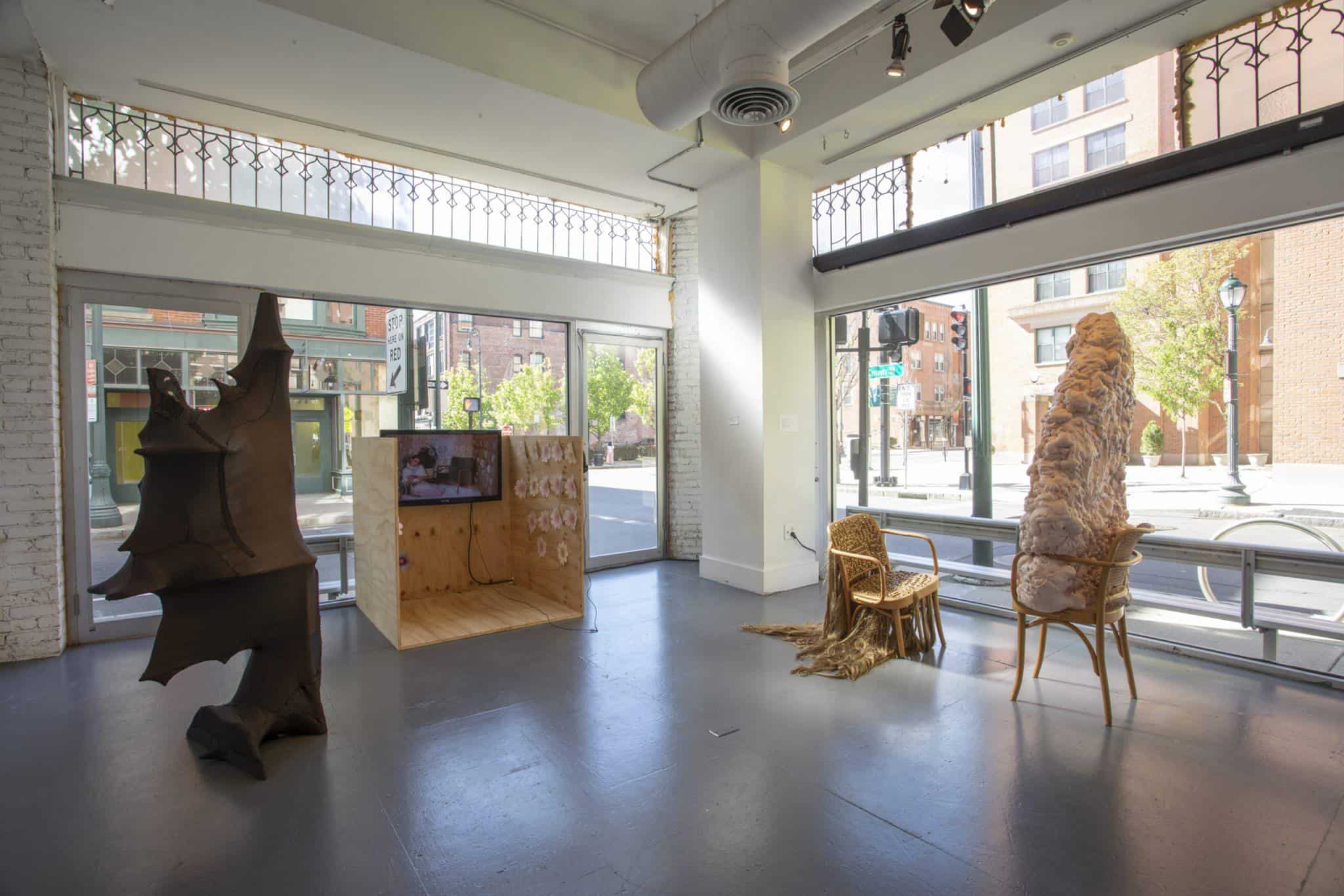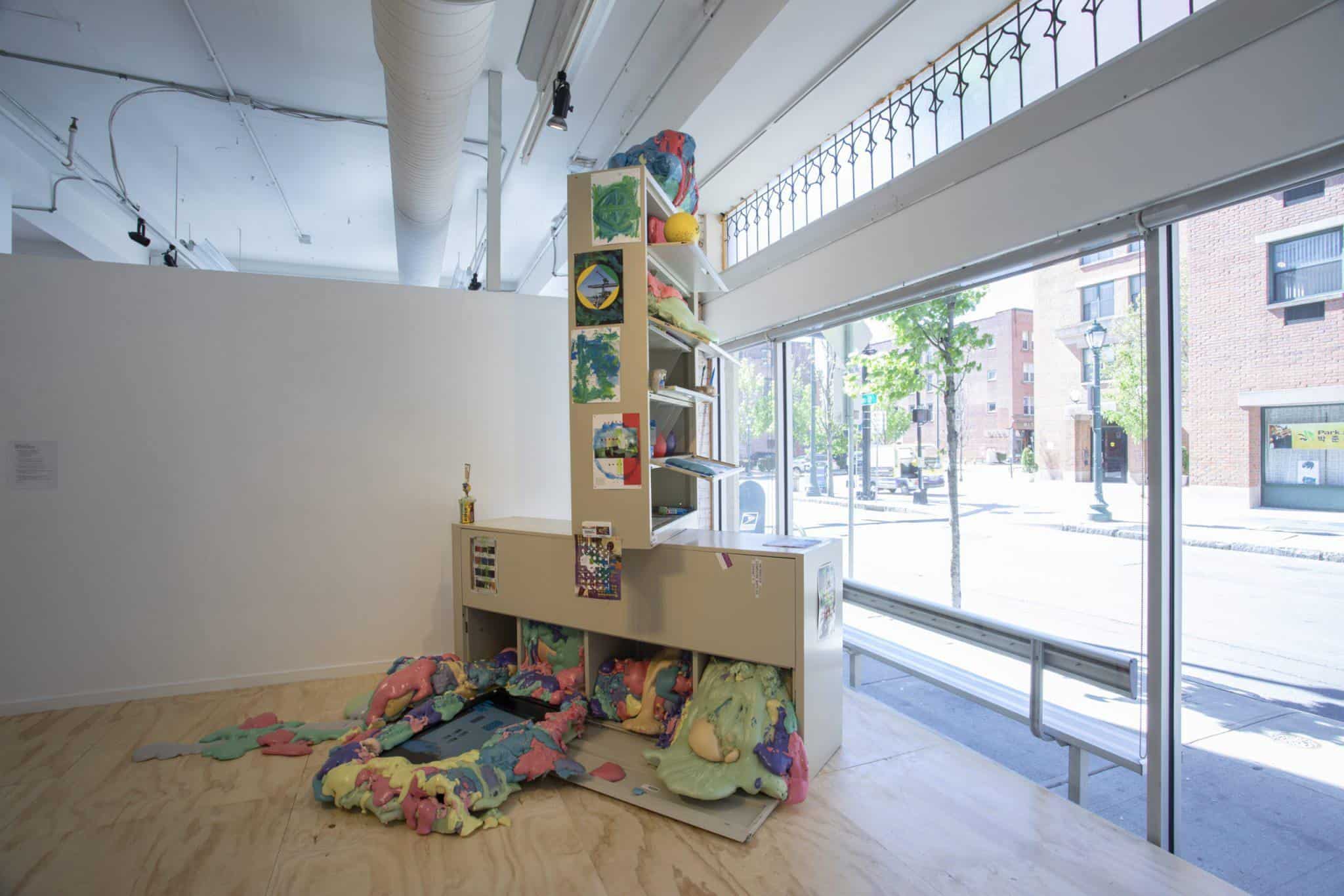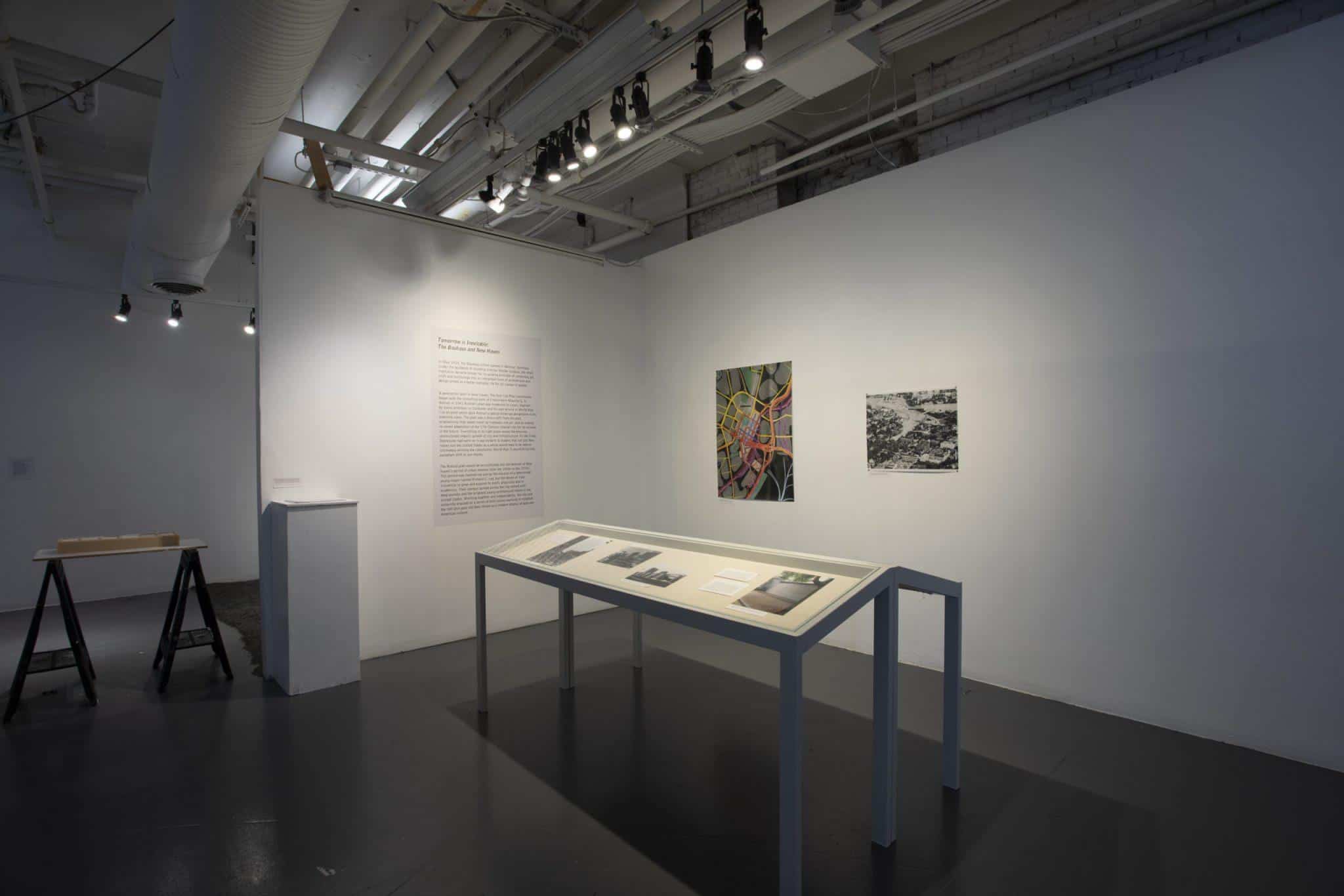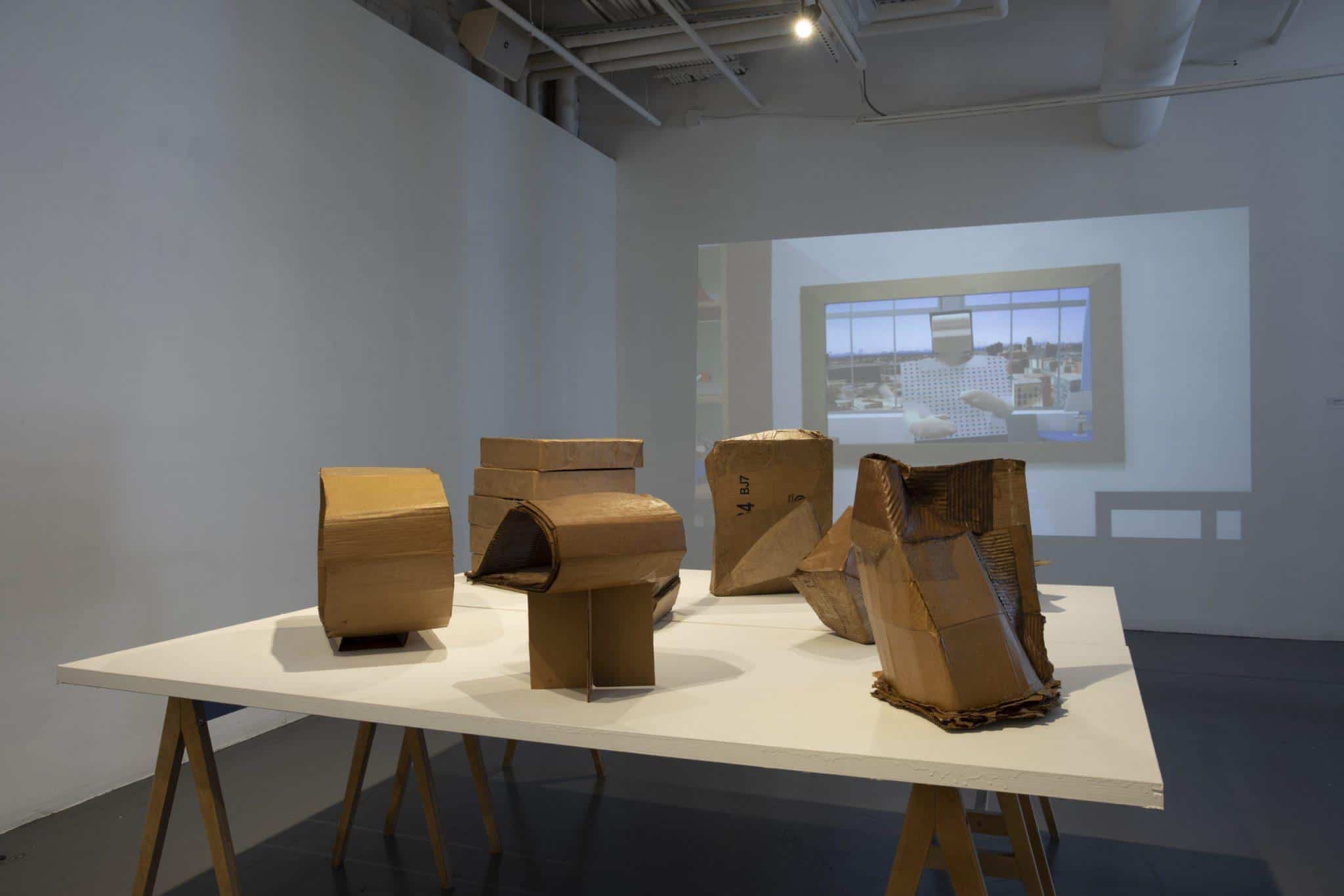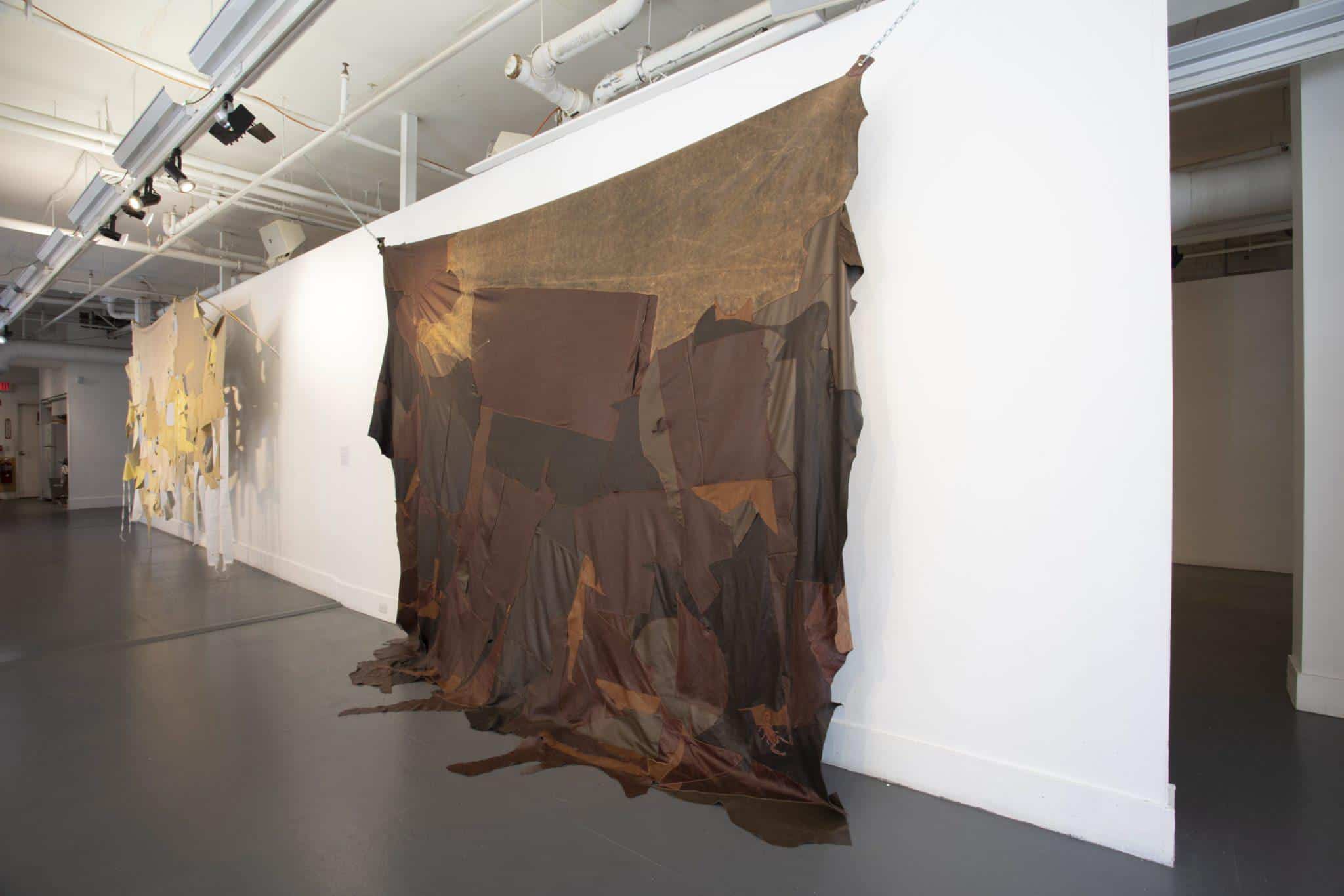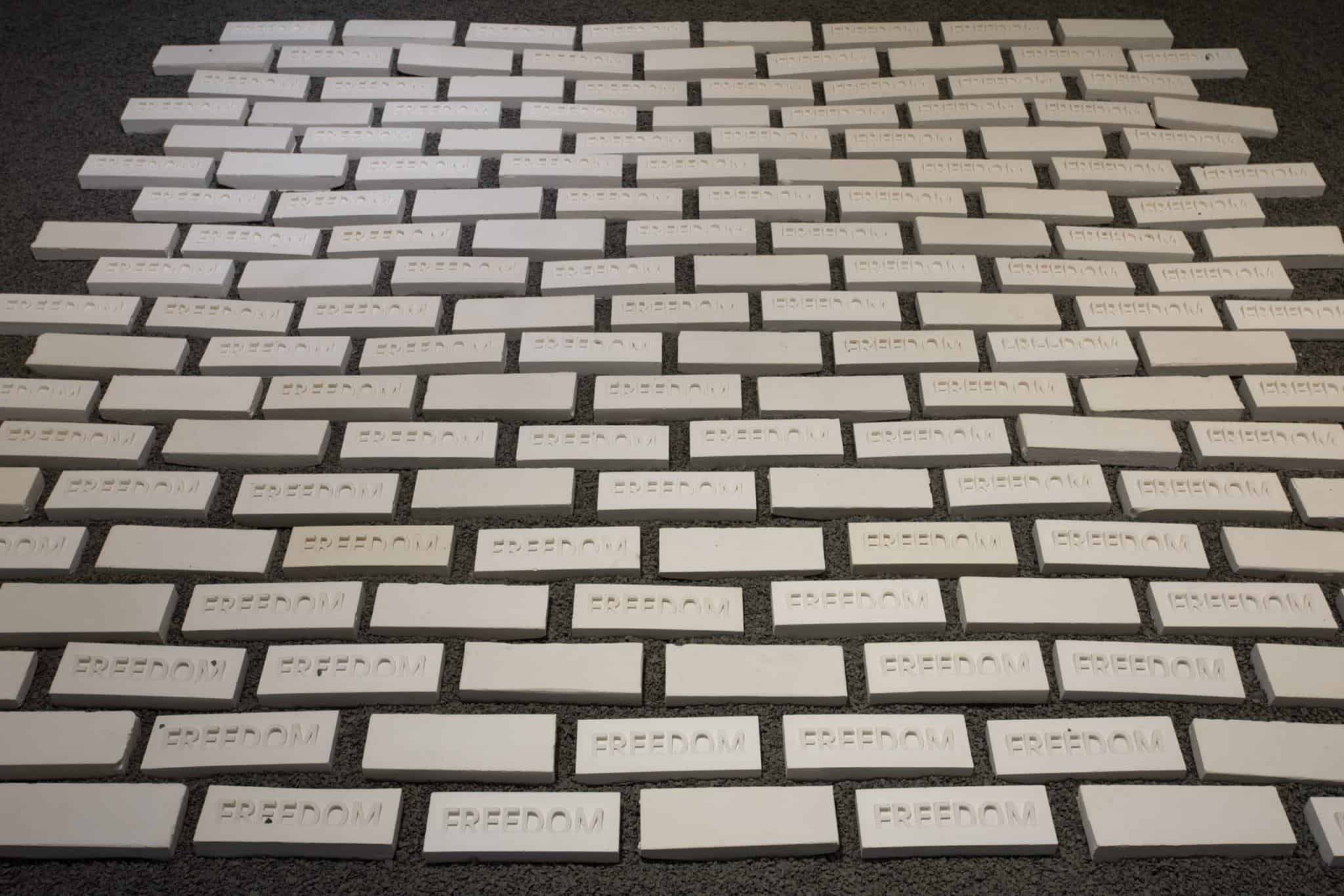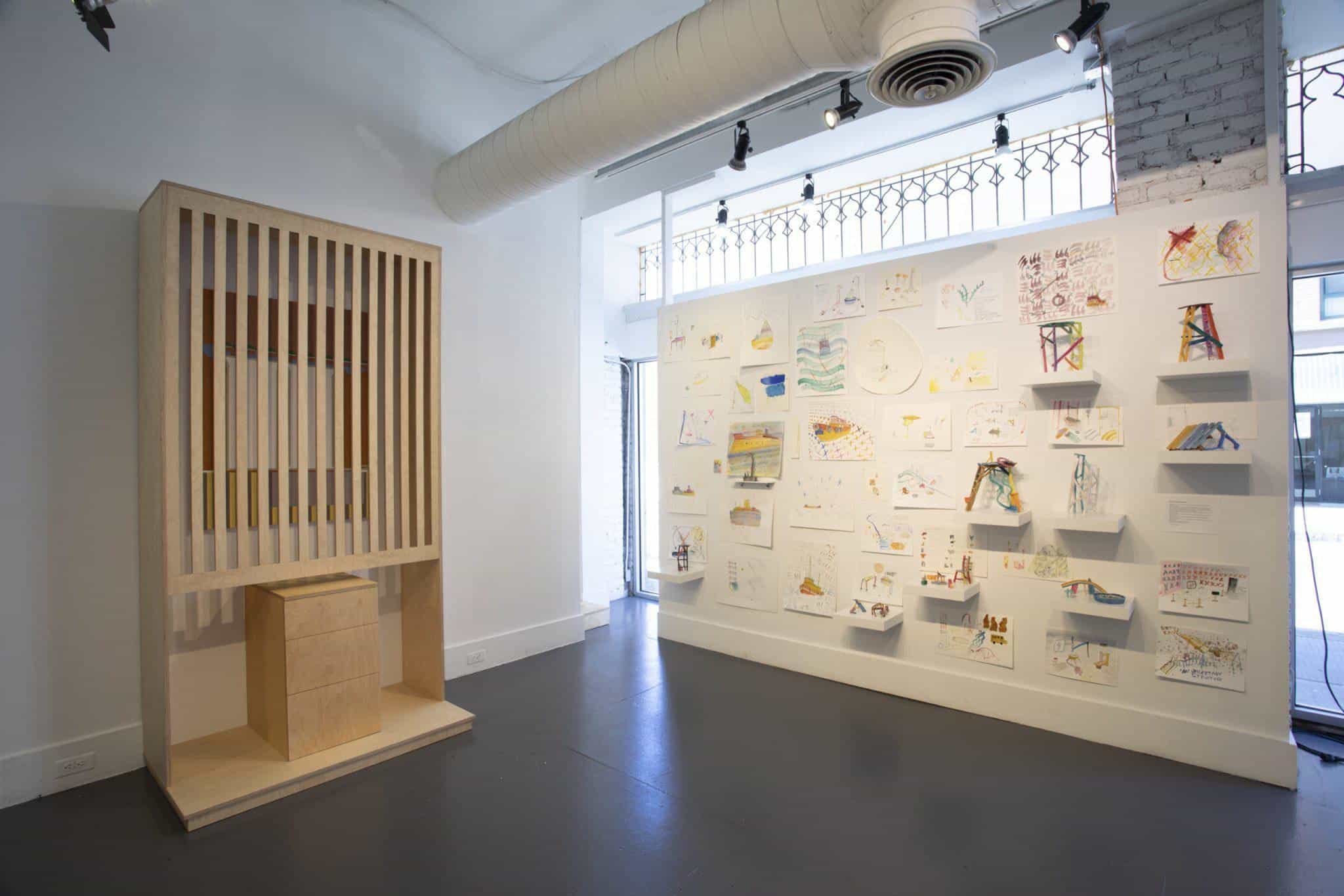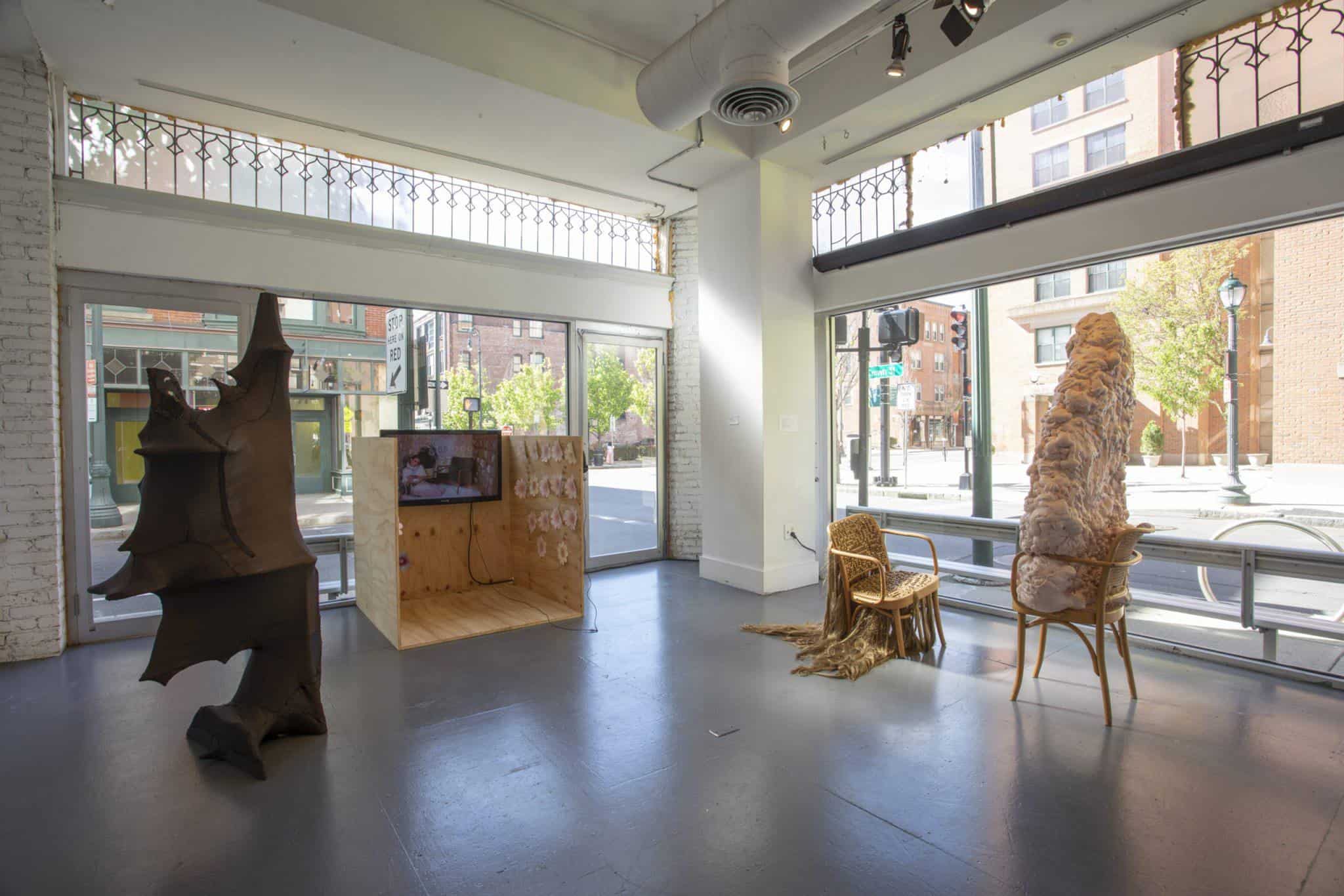
Perverse Furniture
Curated by Sarah Fritchey and Aude Jomini
May 19—June 29, 2019
Graham Anderson, Johanna Bresnick, Bernadette Despujols, Brian Galderisi, Robert Gregson, Crystal Heiden, Robert Chase Heishman and Megan Schvaneveldt, Meredith James, Kyle Kearson, Juliana Cerqueira Leite, Esteban Ramón Pérez, Robert Narracci, Jeff Ostergren, Jessi Reaves, Chris Ruggiero and Nina Yuen.
installation view Perverse Furniture, 2019. Photo credit Jessica Smolinski.
per•verse /pɚˈvɜrs/ adj.
- willfully determined or disposed to go
- counter to what is expected or desired; contrary
- wayward; cantankerous
- persistent or obstinate in what is wrong
- turned away from what is right, good, or proper
Artspace is pleased to present Perverse Furniture, a group exhibition that upsets conventional notions of furniture to explore a range of materially expressive and emotionally intelligent “designs for the body”. Organized on the 100th Anniversary of the Bauhaus, this exhibition explores how three generations of U.S. based artists grapple with the German school’s legacies and ideological roots. The artists include: Graham Anderson, Johanna Bresnick, Bernadette Despujols, Brian Galderisi, Bob Gregson, Crystal Heiden, Robert Chase Heishman and Megan Schvaneveldt, Meredith James, Kyle Kearson, Juliana Cerqueira Leite, Esteban Ramón Pérez, Robert Narracci, Jeff Ostergren, Jessi Reaves, Chris Ruggiero and Nina Yuen.
The practices on display share Bauhaus’s core concern to understand humankind’s place among machines. But rather than strive for the possibility of a perfect marriage between art, technology and industry, they interrogate the ways that objects serve our physical and psychological needs. Looking broadly at overlaps in art, architecture and design today, the works are aesthetically antithetical to the iconic objects of Bauhaus design.1 In their quests to humanize design, they are inefficient, weepy, oddball, excessive, loud, legible, performative, humorous, participatory, kitsch, impenetrable, impractical, non-functional, overbearing, multicentered, uneven, empathetic, multivalent, and sometimes so perverse as to be nearly alive.
Artspace’s galleries at 50 Orange Street are especially fitting for this show, as they formerly housed Chamberlain’s Furniture, a Civil-War Era storefront and furniture factory. Even from the outside, viewers can glimpse at the surprises within. Unpredictable elements bubble up from under the carpets and upholstery in works by Ramón Pérez, Ostergren, Cerqueira Leite, and Reaves, whose broken tools for “living-with” resist the psychological ill-effects of past utopias, and celebrate bodies at rest and in motion. 4 Industrial thrones, cagey mega complexes, obtrusive paneling, and wooly underbellies in works by Kearson, James, Anderson and Despujols, defy our perspectives, turning the tables on power structures of functional design. Aspirational assemblages by Galderisi, Heiden, Bresnick, and Chase Heishman and Schvaneveldt are fraught with tension, absurdity and laughter, signaling that there is hope.
As the 100th Anniversary of Bauhaus is celebrated by major institutions around the world, this exhibition seeks to recognize how the school’s design principles, utopian philosophies and promise of new beginnings have played out at the scale of the city, specifically in New Haven. 2 From the 1930’s to the 1970’s, New Haven became a laboratory for well-known Bauhaüslers in exile, who occupied teaching positions at Yale and nearby Harvard, as well as schools further afield in Chicago, the woods of North Carolina and California.3 Their architectural contributions command attention: among them, the Marcel Breuer building, curiously perched on 1-95, the Paul Rudolph parking lot, which serves Bowtie Cinemas and businesses on Temple Street, and “The Whale” hockey rink built by Eero Saarinen. These urban interventions rejected America’s Beaux Arts tradition practiced in the field and taught in universities. Less obvious are some of the building’s origin stories, filling in bulldozed and reorganized sections of the city under Mayor Richard C. Lee’s aggressive urban renewal campaign of the 1950s and 1960s, often times with little to no community buy-in.
At the core of the exhibition, a specially curated zone explores the mixed reception and nuanced effects of Bauhaus-inspired modernist design in New Haven from the 1950s to today. One section, curated from materials in the Photo Archives and Manuscripts at the New Haven Museum by historian Jason Bischoff-Wurstle, accounts for some of the bizarre spatial mysteries we encounter throughout the city. This section also tells lesser-known stories of early city planning and the implementation by the unique confluence of public and private entities in the remarkable years after World War II. Another section, organized by Robert Gregson, addresses alluring encounters with the hidden glass prisms of residential Connecticut modernism. A third section looks to Yale University’s foundation course on “The Chair” as an example of how American students of architecture are still taught lessons in direct material engagement, scalability and authorship via the Bauhaus tradition of “learning by doing”.
In 1911, the French philosopher Henri Bergson wrote, “We shall see that the human intellect feels at home among inanimate objects, more especially among solids, where our action finds its fulcrum and our industry its tools; that our concepts have been formed on the model of solids; that our logic is, pre-eminently, the logic of solids.”6 For Bergson, our comfort with inanimate objects leads to a dense web of making discovery after discovery, a process which makes it impossible to determine where one discovery ends and the next begins, or where the animate ends and the inanimate begins. Here, human and object are fully enmeshed.
This exhibition is co-curated by Artspace Curator/Gallery Director, Sarah Fritchey, and New Haven based architect/artist, Aude Jomini. It was made possible by the generous support of The Andy Warhol Foundation of the Arts, New Haven Museum, Yale University School of Architecture, and Friends of Artspace.
“..lots of ideas, emotional weight and intellectual rigor.”
—Judy Birke, New Haven Register, May 26, 2019.
View video from our June 27, 2019 event “Reception of the Bauhaus in New Haven” here.
About the Curators
Sarah Fritchey is a curator and writer based in New Haven, Connecticut, whose work explores the entanglement of identity, desire and place. Since 2014, she has served as Artspace’s Curator/Gallery Director, focusing the organization’s energies on the presentation of thematic group shows, educational initiatives and free public programs that address some of the longest standing social injustices of our time. She holds an M.A. in Curatorial Studies from CCS Bard (2013), a B.A. in Comparative Literature and Studio Practice from Hamilton College (2005), and is a graduate of No Longer Empty’s Curatorial Lab (2017). Driven by the philosophy that “one place understood helps us understand all other places better,” she dedicates her practice to connecting audiences with one another and their local surroundings.
Aude Jomini is a Swiss and American artist and designer, interested in collaborative art practice and cross-disciplinary projects related to architecture and art that can foster community. She is currently a Senior Associate at Pelli Clarke Pelli Architects, and has served on Artspace’s Curatorial Advisory Board since 2015. She holds a B.F.A. from RISD (2001), and a M-ARCH from Yale School of Architecture (2010). Before pursuing architecture, Aude worked as a freelance designer in graphic, web, product, and furniture design in New York. She has worked for several art not-profits, including Printed Matter Inc. and Brooklyn Museum as a Curatorial Intern. She has participated in several projects locally, including City-Wide Open Studios: Wellbeing (2018), where she worked with a team of medical professionals, visual and sound artists, designers and scholars to produce “A Center for Adult Swaddling”, and City-Wide Open Studios: F[r]act or Fiction (2017), where she collaborated on “Upside Down New Haven”, a multi-media flexible reimagining of the Town Green.
Works Cited
1. While there is no singular binding definition of Bauhaus design, and the impulse to settle on even a complex definition is fraught, the school’s three directors did share some core ideological and aesthetic beliefs. Chief among them were the “idea that a radical break with historicizing architecture and an abandonment of traditional architectural concepts was necessary”, and that they could find a “new and universal formal language for architecture by means of abstraction; denial of symmetry, ornament, and representation; and explicitly visual references to the technical building process.” Source: Kentgens-Craig, Margret, and Lynette Widder. The Bauhaus and America: First Contacts, 1919-1936. Cambridge: MIT Press, 2001: xvii. Print.
2. Bauhaus ideology, rooted in the notion of a comprehensive, scalable, pseudo-scientific system of “objective design” that benefits everyone, searched for expression in planning and urban design as the logical expansion of interior design, furniture, clothing, products and advertising. Founded and propelled by multiple manifestos, it was more than a school of thought, it was a movement, a way forward and a lifestyle.
3. survey of Modernist-era architecture in New Haven can be found at NewHavenModern.org.
4. Cultural theorist Donna Haraway has written about human/non-human encounters as complex ever-changing relationships that resist the tidy determinism of science and capitalism. She coined the term “sympoesis” and the phrases “living-with” and “making-with” to describe how neither an individual nor a system can autonomously make itself or self-organize. Source: Haraway, Donna. Staying with the Trouble: Making Kin in the Chthulucene. Duke University Press Books, 2016: 58. Print.
5. Bergson, Henri, and Arthur Mitchell. Creative Evolution. Dover Publications, 1998. Print.
Mix Tape
We are excited to share a Mix Tape for Perverse Furniture curated by Chris Ruggiero. We suggest listening to these tracks during your commute to and from Artspace.
- Harumi Hosono “Original BGM:”* we are in a manicured, soothing sound space with utopian pretensions; a promise is made.
- Das Kabinette “The Cabinet:” we learn of a mysterious wooden cabinet and a deranged doctor who takes a subject’s body from her/his control.
- Young Marble Giants “Wurlitzer Jukebox:” via another cabinet in the corner, we are compelled to dance, and we do dance; however, an awareness persists that this affect is compulsory.
- Kraftwerk “The Man-Machine:”* we are told that the machine is the answer.
- Space Art “Love Machine:” the time for dancing is over; now the mechanical reproduction can take place.
- Roxy Music “In Every Dream Home A Heartache:” we occupy the viewpoint of a man who ‘blows up’ the trope of ‘treating a woman like an object’ in this macabre tale of treating an object like a woman.
- The Normal “Warm Leatherette:” now we have moved from mechanical coitus to simulating coitus with an object to arrive at the perfect synchronization of coitus and death.
- Bauhaus “The Passion of Lovers:” in case the prior selection didn’t make the point literally enough, exhibit B(auhaus).
- PIL “Poptones:” Act II begins; we are still in a car, but the scene has changed. The song-within-the-song provides the perversion here; we are told of ‘pop-tones’ underscoring our hero’s own abduction and murder in a piece of irony not unlike the famous Tarantino ‘ear-cutting-avec-Stealers-Wheel’ scene.
- Sniff ‘n’ the Tears “Driver’s Seat:” we are reborn again, phoenix-like (or video-game-like), in another car; this time though we are in The Driver’s Seat. Our own sensual experiences of automotive seats are invoked repeatedly in order to bring us deeper into this narrative of romantic/sexual anticipation.
- Joachim Witt “Golderner Reiter:” we take another trip down the highway; this time for an examination of the boundary between sanity and madness manifested by the specter of a looming mental hospital that lies “just outside the walls of city.”
- Larry Wallis “Police Car:” continuing the exploration of discursive boundaries, we now become aware of other vehicles on our road: physical manifestations of state authority, their presence always a possibility.
- Ray Sunshine “Top Secret:” eventually, interpellation can lead to insanity; ordinary objects can become frightful and threatening.
- Buzzcocks “Operation Manual:” Act 3 begins. Within a control society, we may avoid a diagnosis of insanity through various means; one way is via conformity. Here, an ‘operation manual’ with proscribed rules for navigating interpersonal relationships is imagined.
- Glaxo Babies “The is Your Life”: conformity as a strategy can both work-and-not-work. In this telling, we fulfill our socially-proscribed obligations/expectations only to achieve a dual existence in which expressive affect fades and inner tension grows uncontrollable. There is a sense that no material reward, no ‘thing,’ can repair our hidden damage.
- Gang Of Four ”Capital (it fails us now):” eventually, we may recognize our own interpellated condition and revolt. Once this happens, all manner of consumer durables (the Freezer, the Hi-Fi) reveal their ideological character.
- Talking Heads “Once In A Lifetime:” perhaps the answer is that there is no answer. You are Born Into It and you will Die In It and maybe a cheery attitude really is the best stance.
- The Television Personalities “A Picture of Dorian Gray:” Act 4 begins. We recognize our own mortality and fantasize about an object that might carry this burden of impending death, leaving us with endless pleasant days by the river.
- Smog ”Bathysphere:” another strategy to avoid death: imagining an incredible object that could carry us back into an infinite womb. We long for the line-tethering-us-to-shore to be cut.
- OST to Room 237 by William Hutson and Jonathan Snipes “Emotional Architecture:” those are but fantasies, however; death will come and we can only imagine what form it will take. Kubrick was a master of envisioning and manifesting visions of death, as evinced by the uncanny interiors of The Overlook Hotel that are obsessed-over in the film-about-a film Room 237.
- OMD “Architecture and Morality:” perhaps in our last moments we will gain clarity and see connections that were invisible to us during our lives.
- Harumi Hosono “Original BGM”: is this heaven? Could be. Or it could be music commissioned by a 1980s Japanese department store chain as in-store BGM (background music). Repeat from the top.
